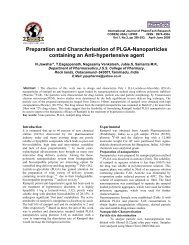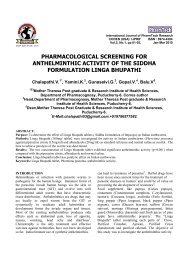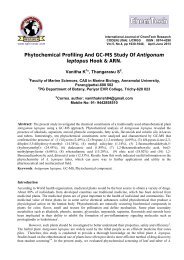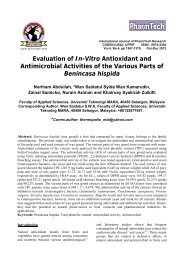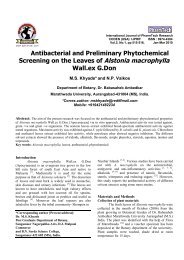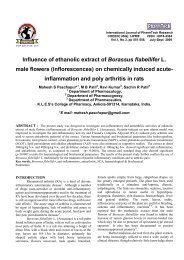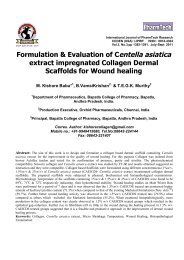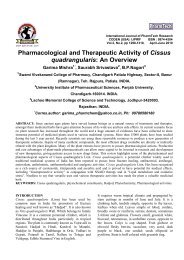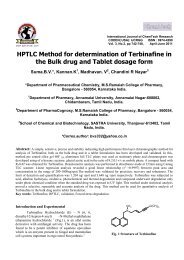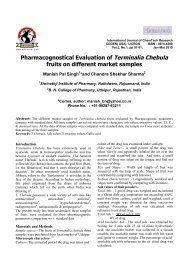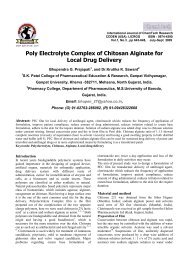epoxidation of wild safflower (carthamus oxyacantha) - Research ...
epoxidation of wild safflower (carthamus oxyacantha) - Research ...
epoxidation of wild safflower (carthamus oxyacantha) - Research ...
Create successful ePaper yourself
Turn your PDF publications into a flip-book with our unique Google optimized e-Paper software.
Pawan D. Meshram et al /Int.J. ChemTech Res.2011,3(3) 1158<br />
Table 3: Effect <strong>of</strong> catalyst loading on iodine value conversion<br />
AIER, IR122 loading (%)<br />
5% 10% 15% 20%<br />
Time (h) 1 4 1 4 1 4 1 4<br />
Oxirane oxygen a (%) 4.17 5.74 4.46 6.51 5.17 6.75 5.93 7.53<br />
Iodine Value b,c (g I2/100g) 76.8 51.2 72.1 40.8 62.3 32.5 49.5 22.6<br />
% Iodine value conversion d (A) 50.4 66.9 53.4 73.6 59.8 78.9 68.1 85.4<br />
Figure 5: Effect <strong>of</strong> temperature on the relative conversion to oxirane. Conditions: acetic acid to ethylenic<br />
unsaturation molar ratio, 0.5:1; hydrogen peroxide to ethylenic unsaturation molar ratio, 1.5:1; catalyst<br />
loading, 20 wt.% <strong>of</strong> oil; stirring speed, 2000 rpm<br />
Effect <strong>of</strong> catalyst loading<br />
In general, increasing the solid catalyst loading leads<br />
to increase in both the total active matter and the total<br />
surface area <strong>of</strong> the catalyst. The active moieties present<br />
in catalyst increases the rate <strong>of</strong> <strong>epoxidation</strong> with<br />
increase in the catalyst concentration in the reaction<br />
system. In our experimentation, IR-122 resin (16-50<br />
wet mesh size, macroreticular form) was used as<br />
catalyst and the effect <strong>of</strong> catalyst loading on the<br />
relative conversion to oxirane is presented in Fig.6.<br />
This figure shows that the conversion <strong>of</strong> ethylenic<br />
unsaturation to oxirane increases rapidly with catalyst<br />
dosage in the beginning and very slowly towards the<br />
end <strong>of</strong> the reaction. The relative conversion to oxirane<br />
increased from 64 to 75% with increasing dosage <strong>of</strong><br />
resin from 5 to 15% after 4 hours <strong>of</strong> reaction. With<br />
use <strong>of</strong> 10% resin a slight oxirane cleavage is observed<br />
after 3 hours <strong>of</strong> reaction and maximum conversion is<br />
72.9%, only 2 units less than that obtained with 15%<br />
catalyst loading. However, the maximum conversion<br />
<strong>of</strong> 84% was obtained with 20% catalyst loading under<br />
identical conditions and the product has stable oxirane<br />
ring. Therefore, 20% catalyst loading was considered<br />
to be optimum for the <strong>epoxidation</strong> reaction.<br />
Figure 6: Effect <strong>of</strong> catalyst loading on the relative<br />
conversion to oxirane. Conditions: Temperature,<br />
60°C; acetic acid to ethylenic unsaturation molar<br />
ratio, 0.5:1; hydrogen peroxide to ethylenic<br />
unsaturation molar ratio, 1.5:1; stirring speed, 2000<br />
rpm



